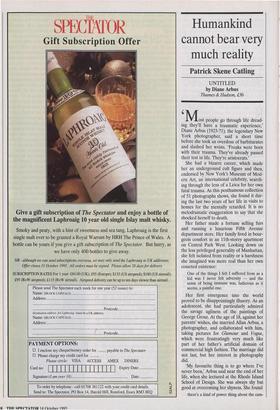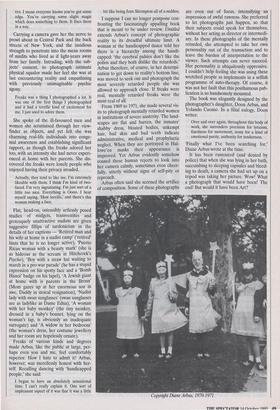Humankind cannot bear very much reality
Patrick Skene Catling
UNTITLED by Diane Arbus Thames & Hudson, £36 6 Most people go through life dread- ing they'll have a traumatic experience,' Diane Arbus (1923-71), the legendary New York photographer, said a short time before she took an overdose of barbiturates and slashed her wrists. 'Freaks were born with their trauma. They've already passed their test in life. They're aristocrats.'
She had a bizarre career, which made her an underground cult figure and then, endorsed by New York's Museum of Mod- ern Art, an international celebrity, search- ing through the lens of a Leica for her own fatal trauma. As this posthumous collection of 51 photographs shows, she found it dur- ing the last two years of her life in visits to homes for the mentally retarded. It is no melodramatic exaggeration to say that she shocked herself to death.
Her father made a fortune selling furs and running a luxurious Fifth Avenue department store. Her family lived in bour- geois comfort in an 11th-storey apartment on Central Park West. Looking down on the less privileged generality of Manhattan, she felt isolated from reality or a harshness she imagined was more real than her own cosseted existence:
One of the things I felt I suffered from as a kid was I never felt adversity — and the sense of being immune was, ludicrous as it seems, a painful one.
Her first emergence into the world proved to be disappointingly illusory. As an adolescent, she had particularly admired the savage ugliness of the paintings of George Grosz. At the age of 18, against her parents' wishes, she married Allan Arbus, a photographer, and collaborated with him, taking pictures for Glamour and Vogue, which were frustratingly very much like part of her father's artificial domain of commercial high fashion. The marriage did not last, but her interest in photography did.
`My favourite thing is to go where I've never been,' Arbus said near the end of her life, when she lectured at the Rhode Island School of Design. She was always shy but good at overcoming her shyness. She found
there's a kind of power thing about the cam- era. I mean everyone knows you've got some edge. You're carrying some slight magic which does something to them. It fixes them in a way.
Carrying a camera gave her the nerve to prowl about in Central Park and the back streets of New York, and the insidious strength to penetrate into the mean rooms of misfits who lived as if light-years away from her family. Intruding, with the sub- jects' consent, to photograph intimate physical squalor made her feel she was at last encountering reality and empathising with previously unimaginable psychic agony.
Freaks was a thing I photographed a lot. It was one of the first things I photographed and it had a terrific kind of excitement for me. I just used to adore them.
She spoke of the ill-favoured men and women she scrutinised through her view- finder as objects, and yet felt she was charming real-life individuals into conge- nial awareness and establishing significant rapport, as though the freaks adored her too, with an intensity she had never experi- enced at home with her parents. She dis- covered the freaks were lonely people who enjoyed having their privacy invaded.
Actually, they tend to like me. I'm extremely likeable with them. I think I'm kind of two- faced. I'm very ingratiating. I'm just sort of a little too nice. Everything is O000. I hear myself saying, 'How terrific,' and there's this woman making a face.
Flat, head-on, ostensibly artlessly posed studies of midgets, transvestites and grotesquely unattractive nudists are given suggestive fillips of sardonicism in the details of her captions — 'Retired man and his wife at home in a nudist camp' ('retired' hints that he is no longer active), 'Puerto Rican woman with a beauty mark' (she is as hideous as the scream in Hitchcock's Psycho), 'Boy with a straw hat waiting to march in a pro-war parade' (he has a stupid expression on his spotty face and a 'Bomb Hanoi' badge on his lapel), 'A Jewish giant at home with is parents in the Bronx' (Mom gazes up at her enormous son in awe, Daddy in stoical resignation), 'Nudist lady with swan sunglasses' (swan sunglasses are as ladylike as Dame Edna), 'A woman with her baby monkey' (the tiny monkey, dressed in a baby's bonnet, lying on the woman's lap, is obviously an inadequate surrogate) and 'A widow in her bedroom' (the woman's dress, her costume jewellery and her room are hopelessly ornate).
Freaks of various kinds and degrees made Arbus, like the public at large, per- haps even you and me, feel comfortably superior. How I hate to admit it! Arbus, however, was mercilessly honest with her- self. Recalling dancing with 'handicapped people,' she said:
I began to have an absolutely sensational time. I can't really explain it. One sort of unpleasant aspect of it was that it was a little bit like being Jean Shrimpton all of a sudden.
I suppose I can no longer postpone con- fronting the fascinatingly appalling book that is meant to be under review. Untitled extends Arbus's concept of photographic reality to its dreadful ultimate limit. A woman at the handicapped dance told her there is a hierarchy among the handi- capped: 'the cerebral palsies don't like the polios and they both dislike the retardeds.' Arbus therefore, of course, in her determi- nation to get down to reality's bottom line, was moved to seek out and photograph the most severely retarded people she was allowed to approach close. If freaks were real, mentally retarded freaks were the most real of all.
From 1969 to 1971, she made several vis- its to photograph mentally retarded women in institutions of severe austerity. The land- scapes are flat and barren, the inmates' shabby dress, bloated bodies, unkempt hair, bad skin and bad teeth indicate administrative, medical and prophylactic neglect. When they are portrayed in Hal- lowe'en masks their appearance is improved. Yet Arbus evidently somehow coaxed these human rejects to look into her camera calmly, sometimes even cheer- fully, utterly without signs of self-pity or reproach. Arbus often said she scorned the artifice of composition. Some of these photographs are even out of focus, intensifying an impression of awful rawness. She preferred to let photographs just happen, so that their subjects could speak for themselves, without her acting as director or intermedi- ary. In these photographs of the mentally retarded, she attempted to take her own personality out of the transaction and to leave the burden of interpretation to the viewer. Such attempts can never succeed. Her personality is ubiquitously oppressive. I couldn't help feeling she was using these wretched people as implements in a selfish programme of auto-therapy. Of course, it was not her fault that this posthumous pub- lication is so handsomely mounted.
The book was elegantly designed by the photographer's daughter, Doon Arbus, and Yolando Cuomo. In a filial eulogy, Doon writes:
Over and over again, throughout this body of work, she surrenders precision for lyricism, fixedness for movement, irony for a kind of emotional purity, authority for tenderness.
'Finally what I've been searching for,' Diane Arbus wrote at the time.
It has been rumoured (and denied by police) that when she was lying in her bath, succumbing to sleeping capsules and bleed- ing to death, a camera she had set up on a tripod was taking her picture. Wow! What a photograph that would have been! The end! But would it have been Art?
Copyright Diane Arbus, 1970-1971











































































 Previous page
Previous page